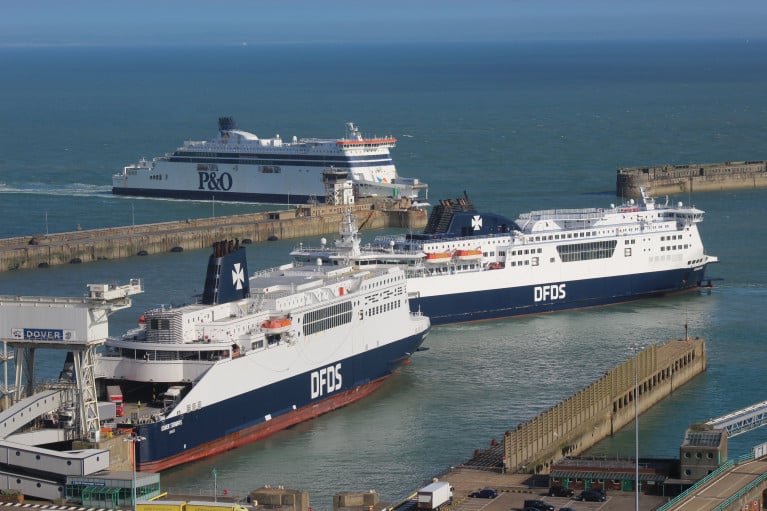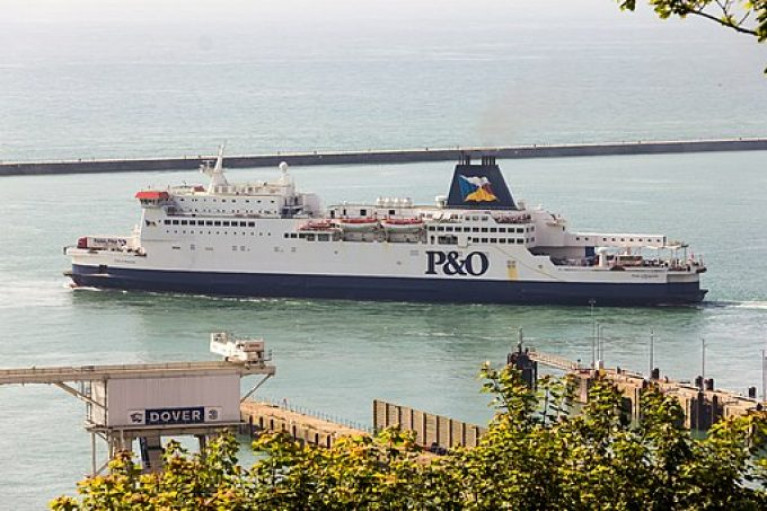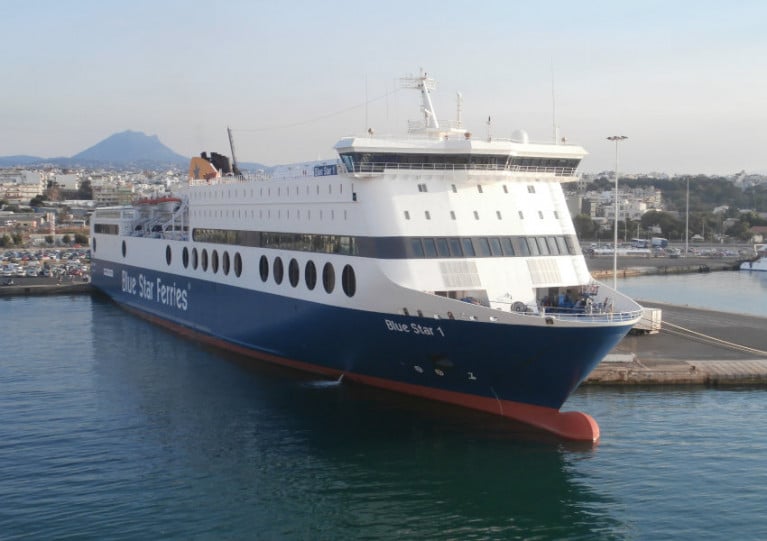Displaying items by tag: Irish Ferries
A P&O Ferries ropax, the Norbay which operated their Dublin-Liverpool route which is set to close before the end of the year, has been time-chartered to ICG, parent company of Irish Ferries, writes Jehan Ashmore.
Afloat.ie contacted P&O Ferries which confirmed with a statement: We are delighted to confirm a time charter agreement with Irish Ferries for our vessel Norbay is for up to 6 months - with the potential for longer-term charter options and that the crew of Norbay will continue to be employed on the vessel during the charter.
Owen Barry, Director of Maritime Operations, P&O said: “Norbay is a great asset to retain within the business with many options for the longer term. Following her upcoming time charter we can either renew, redeploy her in our own fleet to give us great flexibility on other routes, or consider other charter options given the high market demand for this type of vessel. This provides not only ongoing employment for the vessel’s crew but strong options for additional revenue within the business.”
Until now, Norbay has been one of two ships operating on P&O Ferries’ Dublin-Liverpool route. P&O Ferries is now operating one ship on this route, (Afloat adds the Norbank) which is proposed to be closed towards the end of the year due to a lack of berth availability at the port of Liverpool from 2024.
Afloat has consulted the Irish Ferries website and Norbay is first to be deployed to the Dublin-Holyhead route next week, on 7 November. The chartered-in 17,464 gross tonnage Norbay has a 125 freight trailer unit capacity and for 125 passengers, however it appears the ropax will be operating in a freight-only mode.
Noting it is understood that the charter term of the Ireland-Wales route's existing ropax the Epsilon is to expire. Afloat awaits a confirmation from ICG on the freight-orientated vessel which also operates to France, having entered service for Irish Ferries a decade ago this month.
As for a full passenger and freight service on the Dublin-Holyhead route, Irish Ferries continue to maintain with Ulysses on the central Irish Sea corridor route which until recently was also served by the high speed craft, Dublin Swift.
Last month, P&O had withdrawn the Norbay from the Dublin-Liverpool route with a final sailing on 16 October, this involved the overnight 8 hour crossing to Merseyside. This left twin ropax, Norbank as alluded, currently operating as a single-ship service in competition with Seatruck/CLdN, which in response increased capacity on the Irish Sea central corridor route to Dublin where they also have routes to mainland Europe.
It was on Wednesday when Afloat tracked Norbay in the Irish Sea having departed Liverpool, however the ropax headed to Holyhead to conduct berthing trials. The Norbay continued to Dublin with the ropax arriving in th evening notably at Irish Ferries Terminal 1 (berth 51a) and then shifted to berth (49) to facilitate the arrival of ropax Epsilon from Holyhead.
Berth 49 is also where Irish Ferries operate to Cherbourg, noting yesterday’s 1600 hrs sailing from the capital by W.B. Yeats was cancelled due to the adverse weather impacts of Storm Ciaran affecting in particular, north-west France.
To recap, in August P&O announced it was to close the historic Ireland-England route, having cited that the port owners of Liverpool, Peel Ports Group, had a lack of berth availability in 2024, at the Gladstone Dock facility. No sooner had P&O decided to end the Irish Sea route, led Stena Line to express an interest in establishing the Liverpool (Birkenhead)-Dublin route as the ferry operator already has a route from Wirral Peninsula at the Twelve Quays terminal at Birkenhead connecting Belfast.
Originally Norbay which was built in 1992 to serve the P&O owned North Sea Ferries Hull-Rotteram (Europoort) route, together with younger twin, Norbank dating to 1993. In January, 2002 both ropax’s were transferred to the Dublin-Liverpool route and have served the link for almost twenty two years.
More than 1.7m Passengers Port of Dover Welcomed During the Summer
The UK ferryport of Dover has welcomed more than 1.7 million passengers between mid-July and the start of September 2022, which equates to over half of the total number of people it hosted throughout 2021.
According to the port, these figures indicate that it is making “major progress” towards recapturing its pre-pandemic tourist business. Before the pandemic, Dover typically handled two million cars and 11 million passengers per year, making it the busiest international ferry port in the UK.
“Dover has always been a key holiday gateway for British families, and we are very pleased with the strength of the recovery we have seen in tourist traffic,” said Doug Bannister, CEO of the Port of Dover. “Whilst post-pandemic numbers were expected to show a significant increase on last year, these latest figures are very encouraging, and it has been a pleasure to see so many leisure travellers choosing the Straits of Dover once again.”
Ferry&Cruise has more on the port's performance here which Afloat adds includes operator Irish Ferries.
The Dublin based company entered onto the Dover-Calais route last summer in direct competition with P&O Ferries and DFDS.
Revenues and Profits at ICG Surge as Travel Curbs Over
Irish Continental Group which owns Irish Ferries, has reported a surge in revenues and profits for the six month to the end of June as it saw a gradual return towards pre-Covid travel patterns after the disruption of the last two years.
ICG said its revenues for the first half of 2022 jumped by 85.8% to €263.1m from €141.6m the same time last year.
It also reported a profit before tax of €15.4m compared to a loss before tax of €12.2m in the first half of 2021.
ICG said it carried 214,200 cars on its ferries in the first six months of the year - an increase of 618.8% on the same time last year.
Total passenger carryings came to 894,400, an increase of 573.5% on 2021, which it said reflected a gradual return to normal travel patterns compared to a full six-month period of travel restrictions the same time last year in response to the Covid-19 pandemic.
The increase also reflects the impact of six full months of trading on the Dover-Calais route, which started on June 29, 2021, it added.
RTE News reports more here on the group's half-year results.
Irish Ferries MV W.B. Yeats Sustains 'Minor Damage' in Heavier Weather than Forecast
The Irish Ferries W.B. Yeats ran into heavy weather on its Dublin to Cherbourg route last Sunday morning (13th March) resulting in damage to its upper car deck as the video below shows.
The 200-metre long ferry was forced to turn around and return to Dublin Port in the strong winds and big seas as her track of the day below shows.
 Irish Ferries W.B. Yeats
Irish Ferries W.B. Yeats
In a statement, Irish Ferries confirmed that Sunday’s "W.B. Yeats sailing from Dublin to Cherbourg was impacted by heavier weather than forecast which caused some minor damage on the upper car deck. The ship returned to Dublin, which is the normal protocol when these events happen. Irish Ferries rerouted passengers impacted, and apologise for the weather-related disruption.”
MV W.B. Yeats is a RORO passenger and freight vessel. She arrived in Dublin for the first time on 20 December 2018 and entered service in January 2019.
Afloat sources say the ship offloaded its cargo on return to Dublin and headed to the repair dock on Belfast Lough.
French Channel Port of Calais Completes Major Ferry Infrastructure Extension
At the French channel port of Calais yesterday, a €863 million major infrastructure extension was inaugurated that aims to significantly facilitate the transit of freight and passenger ferry traffic.
The port extension, which has taken six years to complete, sees the creation of three ferry stations with “floating gangways” allowing passenger and heavy goods vehicles to be loaded and unloaded on four lanes simultaneously compared with two previously, offering a time saving of 30% per stopover.
A 3-kilometre sea wall has been built, 65 hectares of land has been landscaped, including 45 hectares reclaimed from the sea, and 39 buildings for the operation and reception of port customers have been built too.
LloydsLoadingList has more on the ports UK counterpart at the Port of Dover, which also welcomed newcomer Irish Ferries onto the premier short-sea route in June.
P&O Ferries restored a fifth ship service on the Dover-Calais route, with the recent arrival of Pride of Burgundy at the Port of Dover, this follows new competition from Irish Ferries which last week launched UK-France sailings.
As MultiModal reports, the return of P&O's 28,000-ton Pride of Burgundy, with its first sailing in over a year, brings additional capacity to carry 120 lorries in freight-only mode, making two return journeys each day. The addition of a fifth ship comes in response to growing demand from British and European customers and will expand options for those requiring rapid and reliable transportation of goods between pivotal markets.
First announced in April, the Pride of Burgundy’s return, follows P&O Ferries’ ground-breaking space sharing agreement (with operator DFDS) on the Dover-Calais route, and the introduction of a second lift-on lift-off (LOLO) ship to double capacity between Hull-Zeebrugge.
Peter Hebblethwaite, Managing Director of P&O Ferries, said: “I am delighted to see the restoration of our Dover-Calais fleet to its pre-pandemic strength of five, with the resulting increase in departures and frequency enabling us to take back market leadership on the English Channel and further improve our customer service. Pride of Burgundy will reinforce our cost-effective freight service by increasing capacity and flexibility on the route – a vital artery of trade upon which thousands of businesses and consumers rely.
“With the support of our parent company, DP World, the world’s leading provider of smart logistics solutions, we are committed to bolstering our offering to customers and ensuring optimal efficiency in the flow of goods between the UK and Europe. With international trade at the heart of economic recovery, continual investment in our Dover-Calais route will encourage supply chain resilience by connecting people, businesses and nations.”
Ferry rivals, DFDS & P&O have today entered into a mutual space charter agreement on the Dover-Calais route to shorten freight customers’ waiting times.
The new agreement according to DFDS on the premier short-sea route will also improve the flow of freight traffic across this vital arterial trade link between the UK and France and the rest of the EU member states.
Freight drivers will be able to board the next available sailing when they arrive at the Port of Dover or the Port of Calais, regardless of which of the two ferry companies is operating the crossing. This will ensure customers benefit from more flexibility, with a sailing every 36 minutes. It will reduce the amount of waiting time at the port saving our freight customers up to 30 minutes on their overall journey time.
Whilst the agreement means that capacity is shared, all commercial activities remain entirely under the control of each operator.
The new agreement is for freight vehicles only and does not apply to sailings on the Dover-Dunkirk route, which is solely operated by DFDS and will continue to provide a convenient alternative from Dover, with regular sailings and easy access to the Northern European road network.
Filip Hermann, Vice-President and Head of Channel Routes for DFDS, said: “Our focus is always to improve the ferry offering to freight customers. With this new space charter agreement in Dover-Calais we offer faster crossings and flexibility to relieve congestion and keep trade flowing”.
The two ferry companies carry more than 2.5 million lorries across the English Channel every year, making it the busiest trade route between the UK and Europe, maintaining the flow of essential items including food, medicines and other materials into and out of the UK.
As Afloat previously reported, operator, Irish Ferries next month is to launch a brand new service on Dover-Calais route with the transfer of Isle of Inishmore from Rosslare-Pembroke duties.
Initially, sailings on the UK-France link will be based only for freight customers, providing hauliers with an inclusive UK landbridge post-Brexit connection, as this also includes the operators main Irish Sea route of Dublin-Holyhead.
Irish Ferries and Stena Line, the two key players in Ireland’s ferry industry, are today calling for the reopening of the Common Travel Area (CTA) at the earliest opportunity. They also welcome comments made last week by Tánaiste Leo Varadkar, when he talked about the possibility of restoring the Common Travel Area (CTA) between Ireland and Britain as an “initial first step” for the travel and tourism sectors.
With virus levels now low in Ireland and the UK, and vaccination programmes progressing in both countries, Irish Ferries and Stena Line are calling on Ministers and industry stakeholders to urgently look at restoring the long-standing CTA agreement for Irish and UK citizens, and permit unrestricted travel between Britain and the island of Ireland.
Paul Grant, Trade Director for the Irish Sea, at Stena Line said: “COVID-19 infections are now at low levels and vaccination levels are increasing significantly in both countries. In the UK for example 66% of adults have now received their first dose and 30% have had both, so there is now a real need to focus on solving some of the economic impacts of the pandemic, and an obvious starting point are the hard-hit tourist, hospitality and travel sectors. With the restoring of travel between the islands of Ireland and Britain, we can start to rebuild these sectors locally in advance of the full resumption of international travel, which may take more time to agree and deliver.”
Andrew Sheen, Managing Director for Irish Ferries commented: “The ferry industry has played a key role in helping to keep vital food and medical supply lines open during the height of the pandemic. With the current UK infection rate of 48 cases per 100,000 population comparable to the lowest in Europe, we need to acknowledge the shared land border between the Republic of Ireland and Northern Ireland and eliminate the discrepancies and loopholes on travel restrictions on the island. Irish Ferries and Stena Line welcome the Tánaiste’s recent comments on the possibility of restoring the CTA in advance of the full resumption of international travel and would urge the Irish Government to prioritise its implementation.”
The issue with the CTA has arisen due to differing approaches by the Irish and UK governments. The Irish Government requires passengers from Britain to have a negative PCR test and they must also quarantine for 14 days on arrival. The UK Government has never imposed requirements for testing or quarantine for people travelling from anywhere on the island of Ireland to Britain. The Northern Ireland Assembly also has never imposed testing or quarantine on anyone travelling from Britain.
Both companies are also stressing that they need time to prepare for the resumption of travel. Urgent clarity is needed regarding dates so that the ferry companies can ensure they are ready from an operational perspective.
As Irish Ferries is to become a rival to P&O Ferries on the Dover-Calais market, the ferry firm is set to respond on the UK-France route by deploying a fifth vessel.
The DP World-owned company announced its ro-pax Pride of Burgundy vessel would return to the route in June.
It’s a service the vessel operated for the best part of 26 years before P&O Ferries reduced capacity in response to the pandemic and the cessation of cross-Channel passenger traffic.
More from The Loadstar here.
Irish Ferries has announced the addition of the RoRo passenger ferry Blue Star 1 to its Rosslare–Pembroke Dock route.
The ship is being chartered from the Attica Group and delivery is expected in early April.
Blue Star 1 was built in 2000 by the Van der Giessen de Noord shipyard in the Netherlands, the same shipyard that in 1997 built Irish Ferries’ Isle of Inishmore which is currently servicing the Rosslare–Pembroke Dock route.
Irish Ferries’ pending addition to the fleet has the capacity to carry up to 1,500 passengers, 100 freight vehicles and up to 700 cars depending on freight volume.
The ship offers a host of quality facilities including 192 cabins for freight drivers/passengers, self-service restaurant, café/bar, Club Class lounge, onboard duty-free shop, children’s play area and spacious outdoor decks.
Irish Ferries says the tripling of cabin numbers will facilitate more single occupancy cabins for freight drivers.
Irish Ferries managing director Andrew Sheen said: “We are very pleased to add a quality ship of the calibre of the versatile Blue Star 1 to the Irish Ferries fleet. This ship will be the fastest RoRo passenger ship operating between Britain and Ireland and this will help ensure schedule integrity.
“The introduction of this ship underlines our commitment to the Rosslare-to-Pembroke route, the primary shipping corridor between Ireland and South Wales.
“It also underlines our commitment to the significant contribution that this route makes in facilitating trade for both exporters and importers as well as facilitating essential passenger movements and future tourists as the country reopens post-COVID-19.”
The news comes just says after Irish Ferries launched a new service on the Dover–Calais route set to begin this June — a first for the market leader for freight and passengers between Britain and the Ireland.


































































